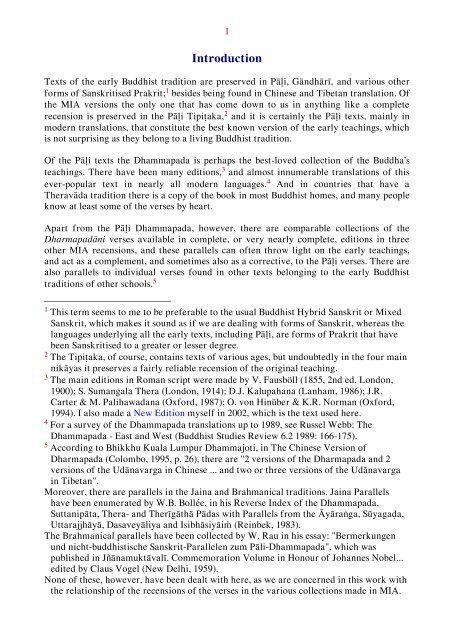A Comparative Edition of the Dhammapada
An edition of the Pāli Dhammapada with parallels from other Indian language traditions, together with a study, and a complete word index. Includes texts from the Patna Dharmapada, Gāndhārī Dharmapada, Udānavarga, Divyāvadāna, Mahāvastu and other texts.
An edition of the Pāli Dhammapada with parallels from other Indian language traditions, together with a study, and a complete word index. Includes texts from the Patna Dharmapada, Gāndhārī Dharmapada, Udānavarga, Divyāvadāna, Mahāvastu and other texts.
Create successful ePaper yourself
Turn your PDF publications into a flip-book with our unique Google optimized e-Paper software.
1<br />
Introduction<br />
Texts <strong>of</strong> <strong>the</strong> early Buddhist tradition are preserved in Pāḷi, Gāndhārī, and various o<strong>the</strong>r<br />
forms <strong>of</strong> Sanskritised Prakrit; 1 besides being found in Chinese and Tibetan translation. Of<br />
<strong>the</strong> MIA versions <strong>the</strong> only one that has come down to us in anything like a complete<br />
recension is preserved in <strong>the</strong> Pāḷi Tipiṭaka, 2 and it is certainly <strong>the</strong> Pāḷi texts, mainly in<br />
modern translations, that constitute <strong>the</strong> best known version <strong>of</strong> <strong>the</strong> early teachings, which<br />
is not surprising as <strong>the</strong>y belong to a living Buddhist tradition.<br />
Of <strong>the</strong> Pāḷi texts <strong>the</strong> <strong>Dhammapada</strong> is perhaps <strong>the</strong> best-loved collection <strong>of</strong> <strong>the</strong> Buddha’s<br />
teachings. There have been many editions, 3 and almost innumerable translations <strong>of</strong> this<br />
ever-popular text in nearly all modern languages. 4 And in countries that have a<br />
Theravāda tradition <strong>the</strong>re is a copy <strong>of</strong> <strong>the</strong> book in most Buddhist homes, and many people<br />
know at least some <strong>of</strong> <strong>the</strong> verses by heart.<br />
Apart from <strong>the</strong> Pāḷi <strong>Dhammapada</strong>, however, <strong>the</strong>re are comparable collections <strong>of</strong> <strong>the</strong><br />
Dharmapadāni verses available in complete, or very nearly complete, editions in three<br />
o<strong>the</strong>r MIA recensions, and <strong>the</strong>se parallels can <strong>of</strong>ten throw light on <strong>the</strong> early teachings,<br />
and act as a complement, and sometimes also as a corrective, to <strong>the</strong> Pāḷi verses. There are<br />
also parallels to individual verses found in o<strong>the</strong>r texts belonging to <strong>the</strong> early Buddhist<br />
traditions <strong>of</strong> o<strong>the</strong>r schools. 5<br />
1<br />
This term seems to me to be preferable to <strong>the</strong> usual Buddhist Hybrid Sanskrit or Mixed<br />
Sanskrit, which makes it sound as if we are dealing with forms <strong>of</strong> Sanskrit, whereas <strong>the</strong><br />
languages underlying all <strong>the</strong> early texts, including Pāḷi, are forms <strong>of</strong> Prakrit that have<br />
been Sanskritised to a greater or lesser degree.<br />
2<br />
The Tipiṭaka, <strong>of</strong> course, contains texts <strong>of</strong> various ages, but undoubtedly in <strong>the</strong> four main<br />
nikāyas it preserves a fairly reliable recension <strong>of</strong> <strong>the</strong> original teaching.<br />
3<br />
The main editions in Roman script were made by V. Fausböll (1855, 2nd ed. London,<br />
1900); S. Sumangala Thera (London, 1914); D.J. Kalupahana (Lanham, 1986); J.R.<br />
Carter & M. Palihawadana (Oxford, 1987); O. von Hinüber & K.R. Norman (Oxford,<br />
1994). I also made a New <strong>Edition</strong> myself in 2002, which is <strong>the</strong> text used here.<br />
4<br />
For a survey <strong>of</strong> <strong>the</strong> <strong>Dhammapada</strong> translations up to 1989, see Russel Webb: The<br />
<strong>Dhammapada</strong> - East and West (Buddhist Studies Review 6.2 1989: 166-175).<br />
5<br />
According to Bhikkhu Kuala Lumpur Dhammajoti, in The Chinese Version <strong>of</strong><br />
Dharmapada (Colombo, 1995, p. 26), <strong>the</strong>re are "2 versions <strong>of</strong> <strong>the</strong> Dharmapada and 2<br />
versions <strong>of</strong> <strong>the</strong> Udānavarga in Chinese ... and two or three versions <strong>of</strong> <strong>the</strong> Udānavarga<br />
in Tibetan".<br />
Moreover, <strong>the</strong>re are parallels in <strong>the</strong> Jaina and Brahmanical traditions. Jaina Parallels<br />
have been enumerated by W.B. Bollée, in his Reverse Index <strong>of</strong> <strong>the</strong> <strong>Dhammapada</strong>,<br />
Suttanipāta, Thera- and Therīgāthā Pādas with Parallels from <strong>the</strong> Āyāraṅga, Sūyagaḍa,<br />
Uttarajjhāyā, Dasaveyāliya and Isibhāsiyāiṁ (Reinbek, 1983).<br />
The Brahmanical parallels have been collected by W. Rau in his essay: "Bermerkungen<br />
und nicht-buddhistische Sanskrit-Parallelen zum Pāli-<strong>Dhammapada</strong>", which was<br />
published in Jñānamuktāvalī. Commemoration Volume in Honour <strong>of</strong> Johannes Nobel...<br />
edited by Claus Vogel (New Delhi, 1959).<br />
None <strong>of</strong> <strong>the</strong>se, however, have been dealt with here, as we are concerned in this work with<br />
<strong>the</strong> relationship <strong>of</strong> <strong>the</strong> recensions <strong>of</strong> <strong>the</strong> verses in <strong>the</strong> various collections made in MIA.
















